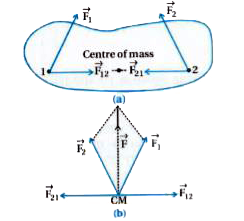Discuss the forces acting on the n particles in a system. Solution in Gujrati
The force acting on centre of mass,
M→A=−→F1+−→F2+...−→Fn here −→F1 is not only one force but it is vector sum of forces acting only a particle.
Similarly for second, third, … .n. particle the vector sum of force actin are −→F2+−→F3+...−→Fn
The forces acting on particles of a system are of two types :
(i) Internal forces due to mutual interactions among the particles and
(ii) External forces
In the figure (a) a system made of particle-1 and particle-2 is shown.

External forces acting on particles 1 and 2 are −→F1and−→F2 respectively and mutual forces interaction are denoted by −→F12and−→F21.
Here, all the forces may be considered as acting on the centre of mass which is shown in figure (b).
According to Newton.s third law of motion the internal forces being equal and opposite their resultant is zero. So the force →F acting on the centre of mass can be regarded as resultant external forces only.
∴M→A=→Fext where →Fext−→F is the resultant force of only external forces.
This equation indicates that the system moves under the effect of resultant external force as if the whole mass of the system where concentrated as its centre of mass.
Topper's Solved these Questions
- BOOK - KUMAR PRAKASHANCHAPTER - SYSTEMS OF PARTICLES AND ROTATIONAL MOTIONEXERCISE - SECTION-A HOTS3videos
SYSTEMS OF PARTICLES AND ROTATIONAL MOTION
- BOOK - KUMAR PRAKASHANCHAPTER - SYSTEMS OF PARTICLES AND ROTATIONAL MOTIONEXERCISE - SECTION-A (TRY YOURSELF (VSQs))94videos
SYSTEMS OF PARTICLES AND ROTATIONAL MOTION
- BOOK - KUMAR PRAKASHANCHAPTER - QUESTIONS ASKED IN JEE - 2020 EXERCISE - Question16videos
QUESTIONS ASKED IN JEE - 2020
- BOOK - KUMAR PRAKASHANCHAPTER - THERMAL PROPERTIES OF MATTEREXERCISE - Question Paper (Section - D) (Answer following in brief :) Each carry 4 marks1videos
THERMAL PROPERTIES OF MATTER
Similar Questions
What is torque? Explain the torque acting on a particle.
01:09View SolutionWhat is a rigid body ? Explain the differences between rigid body and solid body.
04:11View SolutionA non-isotropic solid metal cube has coefficient of linear expansion as 5×10−5/∘C along the x-axis and 5×10−6/∘C along y-axis and z-axis. If the coefficient of volumetric expansion of the solid is n×10−6/∘C then the value of n is....
03:06View SolutionIn an experiment on the specific heat of a metal, a 0.20 kg block of the metal at 150∘C is dropped in a copper calorimeter (of water equivalent 0.025 kg) containing 150 cm3 of water at 27∘C. The final temperature is 40∘C. Compute the specific heat of the metal. If heat losses to the surroundings are not negligible, is your answer greater or smaller than the actual value for specific heat of the metal ?
01:13View SolutionA particle is simultaneously acted by two forces equal to 4 N and 3N . The net force on the particle is
02:12View SolutionA particle is acted upon by only a conservative force F=(7hat(i)-6hat(j)) N (no other force is acting on the particle). Under the influence of this force particle moves from (0, 0) to (-3m, 4m) then
03:43View SolutionSelect the correct alternative. When there is no external force acting on a system of particles,
01:06View SolutionInternal forces acting within a system of particles can alter
00:39View SolutionTwo forces of 12 N and 5 N are acting on a particle , with an angle of 60^(@) between them , Calculate the resultant force .
01:09View SolutionWrite the expression of centre of mass of a system of .n. particles and derive the formula of force acting on its centre of mass.
01:08View SolutionWhich types of force acting on the system of particle?
04:33View SolutionIf the external force acting on a system of particle is zero then …………..
03:48View SolutionInternal forces acting in a system of particle can change
02:40View SolutionInternal forces acting in a system of particle can change
01:20View SolutionA particle is simultaneously acted by two forces equal to 4 N and 3N . The net force on the particle is
03:04View Solution

